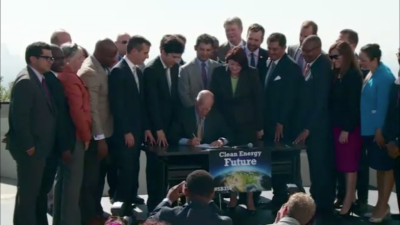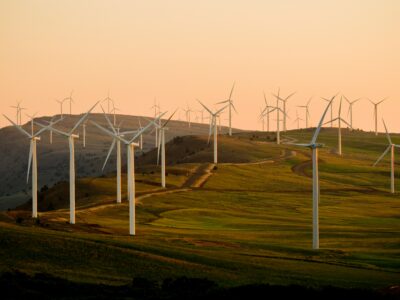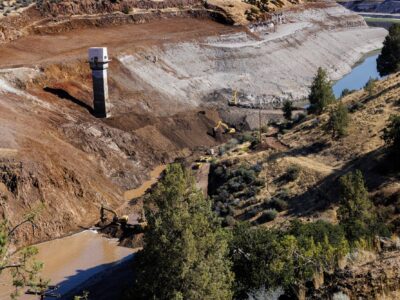California Enshrines Renewables And Energy Efficiency 2030 Goals — And Maybe Greenhouse Gas Goals, Too
Buried provision in the bill codifies long-term climate goals in the context of vehicle electrification
Today Governor Jerry Brown signed SB 350 (De Leon), a landmark bill that pledges California to a 50% renewable goal by 2030, as well as a doubling of energy efficiency in existing buildings by that date. Despite the environmental win, it’s been well-reported by the media and others that California’s environmental leaders got beaten pretty badly this last legislative session by the oil industry. Faced with a provision in SB 350 that would mandate 50% petroleum reduction by 2030 and a bill to codify 2030 and 2050 greenhouse gas reduction goals (SB 32), the industry launched a multi-million dollar campaign, full of false claims of impending gas rationing and price spikes, and targeted it at “moderate” Democrats in the legislature.

The plan worked. These democrats helped lead SB 32 to its demise and stripped SB 350 of the petroleum reduction goal.
But is it possible that the oil industry representatives missed an important provision in SB 350 relating to long-term greenhouse gas reduction goals? Buried on page 59 in SB 350, the legislature for the first time codified the goal of reducing greenhouse gas emissions to 40 percent below 1990 levels by 2030 and 80 percent below those levels by 2050. The provisions begin in the findings section on the need to electrify transportation, via amendments to the state’s Public Utilities Code:
740.12. (a) (1) The Legislature finds and declares all of the following:
…
740.12. (a) (1) (D) Reducing emissions of greenhouse gases to 40 percent below 1990 levels by 2030 and to 80 percent below 1990 levels by 2050 will require widespread transportation electrification.
The legislation then directs utilities to file applications with the California Public Utilities Commission (CPUC) for programs to electrify transportation in order to meet these climate goals:
740.12. (b) The commission, in consultation with the State Air Resources Board and the Energy Commission, shall direct electrical corporations to file applications for programs and investments to accelerate widespread transportation electrification to reduce dependence on petroleum, meet air quality standards, achieve the goals set forth in the Charge Ahead California Initiative…, and reduce emissions of greenhouse gases to 40 percent below 1990 levels by 2030 and to 80 percent below 1990 levels by 2050 [italics added].
So in the context of electrifying transportation and utilities role in achieving it, the 2030 and 2050 goals are now law, giving the CPUC broad regulatory authority to achieve those goals in this sector.
This is no small potatoes. Electrification of transportation is absolutely essential to meeting long-term climate goals, given that almost 40 percent of emissions come from transportation. In the 50% petroleum reduction debate, it was clear that much of the decrease will be achieved anyway by 2030 given improved federal fuel economy standards and a continued leveling off of vehicles miles traveled per capita in the state – both of which basically would occur without any additional legislative action. But electrification of transportation will still be dependent on state action for the near term, including support for greater deployment of public charging stations and state rebates for electric vehicles purchases and leases, among other policies to boost this nascent industry. The 2030 and 2050 goals for electric vehicles now give the CPUC specific marching orders that would essentially achieve the 2030 petroleum reduction anyway, even without it being specifically called out in SB 350.
To be sure, this codification won’t benefit the full range of climate measures that California is taking for the years beyond 2020, when AB 32 authority plateaus. For example, other alternatives to petroleum, namely biofuels, are not covered by this provision. Currently, the low carbon fuel standard, a regulation under AB 32 authority, is the primary driver of biofuel deployment. Biofuels will be necessary to reduce emissions in the short term for passenger vehicles, at least until battery electrics become cheaper and better, and in the long-term for transportation like aviation and long-haul trucking that isn’t otherwise suitable for battery electrification. Cap-and-trade is also specifically authorized by AB 32 through 2020 and wouldn’t continue based solely on SB 350. In general, regulations from the California Air Resources Board to address climate pollution not tied to renewables, energy efficiency or electrification of transportation couldn’t be extended based solely on these provisions.
But the provisions could have another immediate impact, specifically with litigation over regional and local plans that may fail to take into account long-term climate goals. Most famously, San Diego’s regional transportation plan purports to reduce emissions from driving through 2035 but then backslides out to 2050. The agency argued it didn’t have to study the impacts out to 2050 because the goals are merely based in an executive order. The case is pending before the State Supreme Court on this issue (full disclosure: I co-authored an amicus brief with Legal Planeteer Rick Frank and Jayni Hein supporting the petitioner’s claims about the plan’s failure to study long-term impacts). But now petitioners in litigation like this one have a stronger case that the goals are in fact codified in legislation, and specifically in the transportation context.
And perhaps more importantly, these SB 350 provisions could now create a worthy rival to Big Oil. Big Utilities are itching to get into the electrification game, and they have the resources and power to compete with Big Oil in these legislative showdowns. While California doesn’t want to crowd out the electric vehicle space with utility entrenchment, the state will certainly need utilities to help with charging infrastructure and programs to manage the charging load more effectively. The provisions on Page 59 take the state down that path in a significant way, and the oil industry may soon regret their inclusion.
So while the environmental community has much to cheer about with today’s signing in terms of renewables and energy efficiency, they shouldn’t overlook the important greenhouse gas provisions that may have an even more transformative effect on California’s long-term climate program — and the oil industry’s efforts to limit it.







Reader Comments